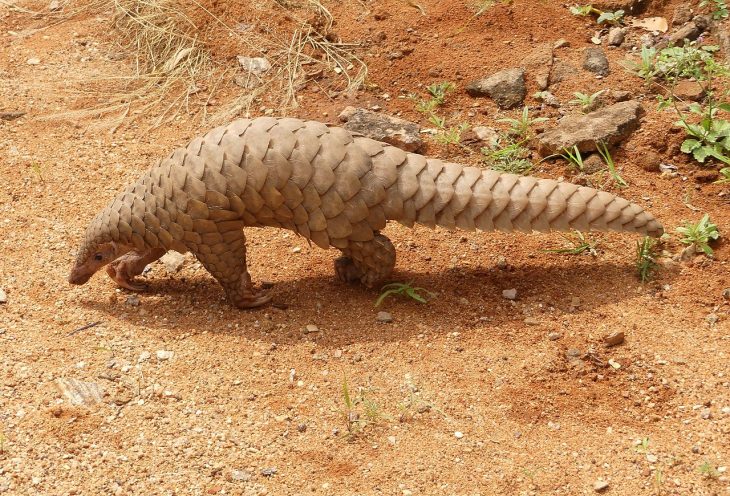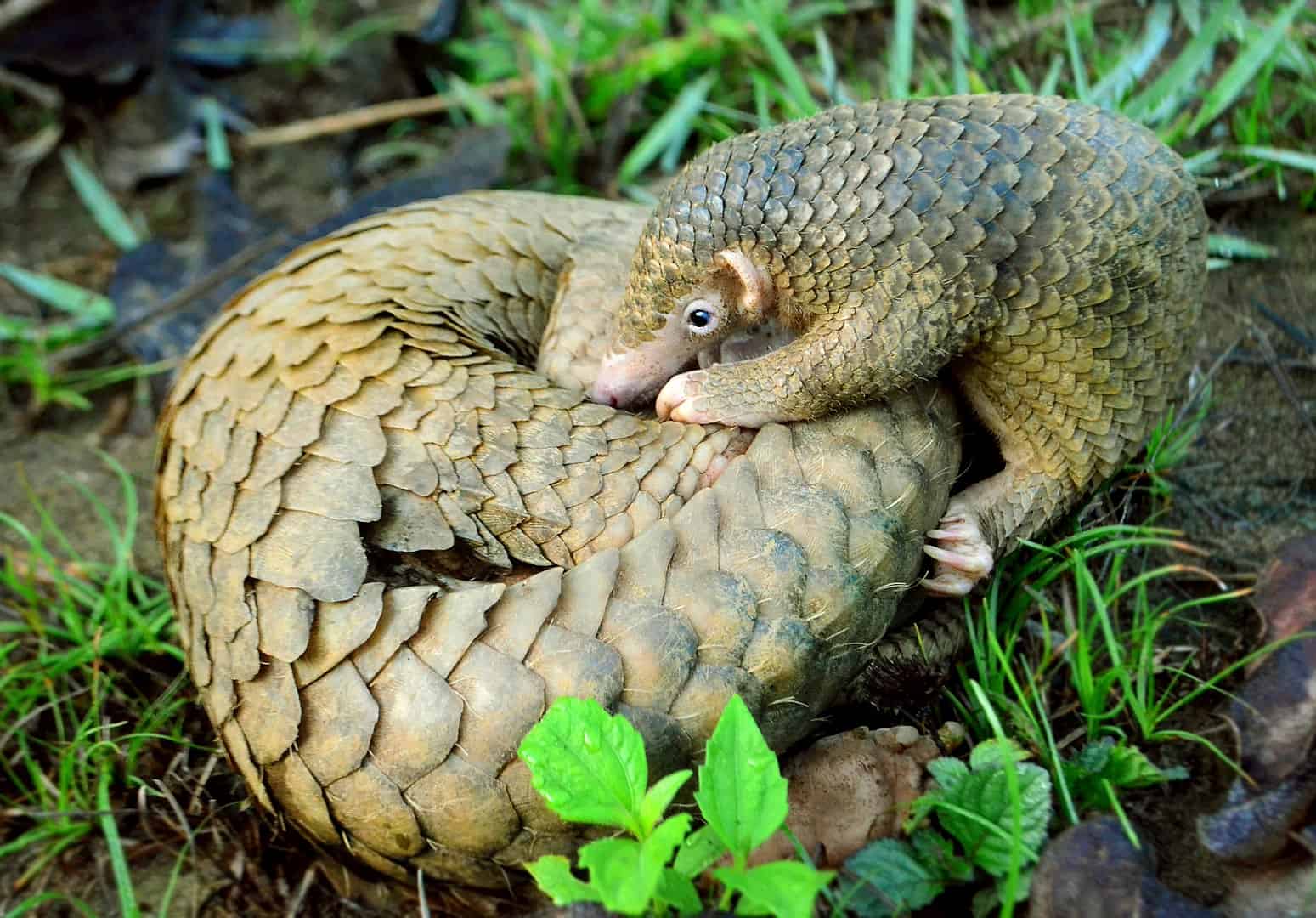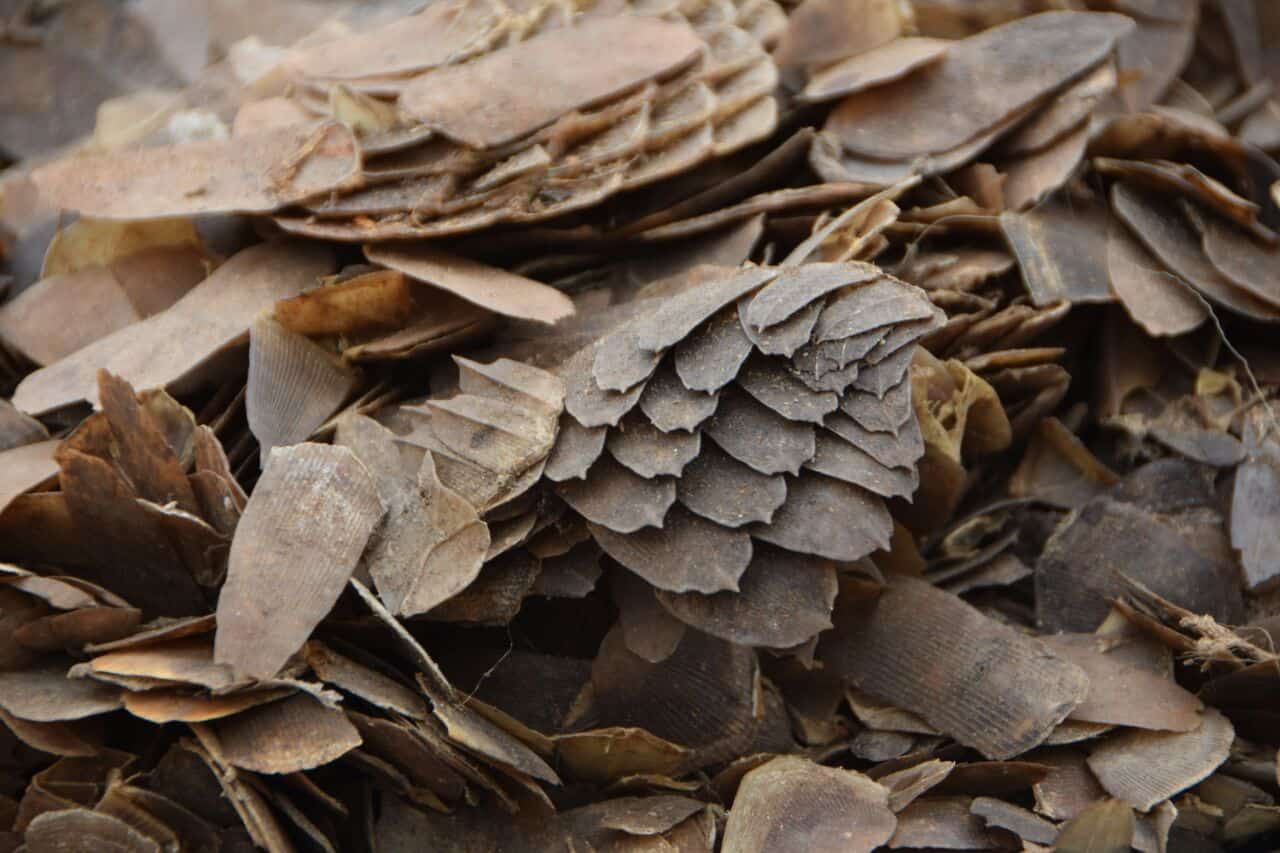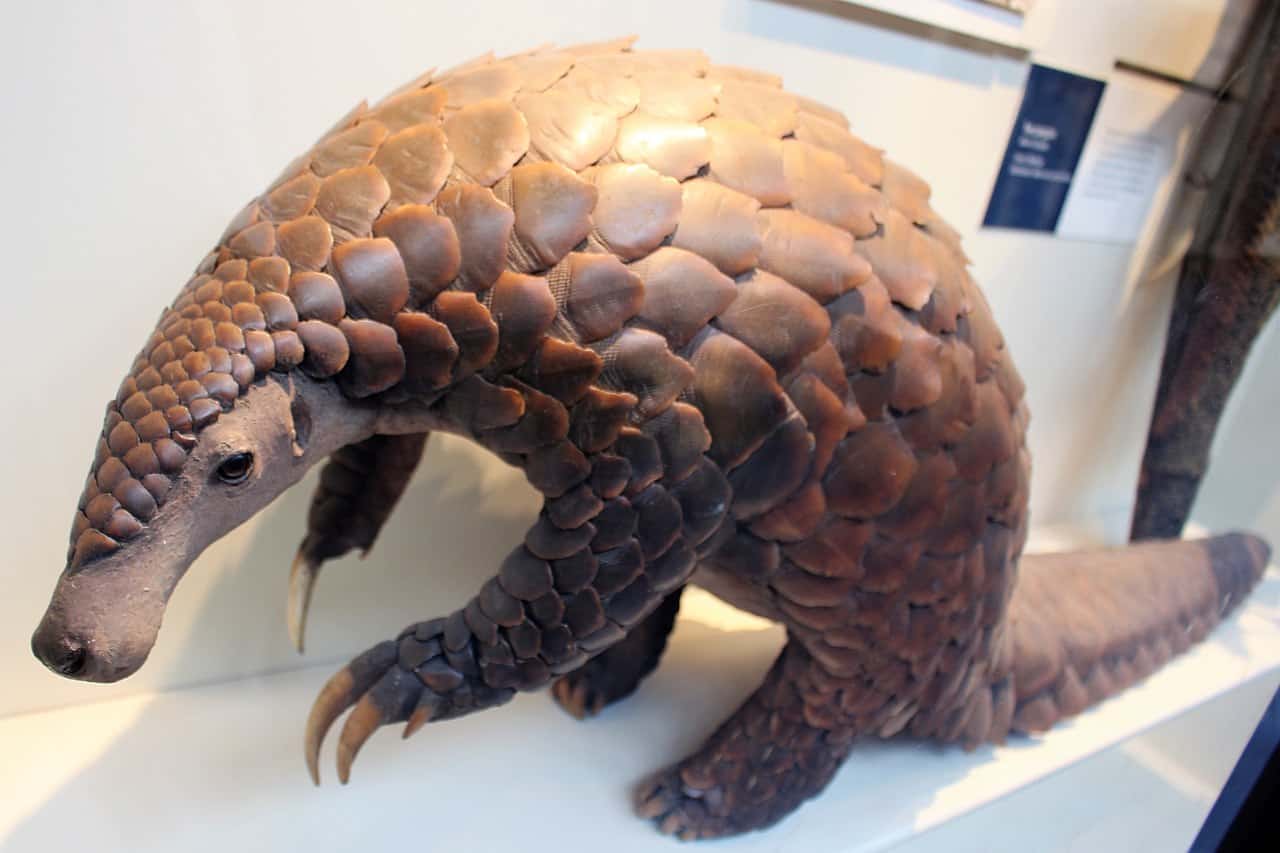
Pangolins are such gentle and innocent animals. Through no fault of their own, these harmless creatures are cruelly and unfairly treated by all too many people. So here are 50 pangolin facts, with which to get to know them and how we all ought to treat them better.
- Pangolins vary in length from 30 to 100 cm.
- Pangolins have long tongues, up to 40 cm when fully extended.
- Pangolin dens can go as deep as 3.5 meters underground.
- Pangolins are big eaters, consuming between 140 to 200 grams of insects in a day.
- It takes between 70 to 140 days for a pregnant pangolin to give birth.
- Pangolins are mammals.
- Unlike most mammals, pangolins have scales growing on top of their bodies.
- When in danger, pangolins curl up into a ball with their scales on the outside to protect them.
- Pangolin scales are hard enough to stop a lion’s bite.
- Pangolins live in either underground lairs or in treetop nests.
- Pangolins do not mate for life.
- Pangolins usually give birth to only one child, but twins are sometimes born.
- Like all mammals, a baby pangolin feeds on their mother’s milk.
- Baby pangolins are born with soft scales that harden shortly afterward.
- Pangolins are nocturnal animals.
- A baby pangolin is often seen riding their mother’s tail.
- Pangolins eat with their eyes and noses closed to keep insects from getting to them.
- Pangolins are also known as scaly anteaters.
- Pangolins have no scales on their bellies.
- Pangolin scales have sharp edges, enough to leave wounds on anything soft they cut.
The word pangolin comes from the Malay word penggulin.

Penggulin means rolling over. This references how a pangolin rolls up to protect itself from danger.
There are 8 pangolin species in the world.
Four of those species reference the country they’re found in. Those are the Chinese Pangolin, the Sunda Pangolin, the Indian Pangolin, and the Philippine Pangolin. Other species reference their preferred residence. These are the Tree Pangolin and Temmink’s Ground Pangolin. The last two species refer to physical characteristics unique to the species. These are the Long-tailed Pangolin and the Giant Pangolin.
Pangolin scales are of the same material as fingernails.

We mentioned earlier how pangolin scales are hard enough to stop a lion’s bite. So here’s a surprise from pangolin facts. A pangolin’s scales are of keratin like fingernails. Hair is also keratin. Talk about a versatile material.
Pangolins mark their territories.
We’re sure you know how other animals like cats and dogs mark their territories. Unlike them though, pangolins don’t use urine to mark their territory with. Instead, they use a special fluid produced by glands near their anus. By rubbing their backsides on the ground or a tree, they spread that fluid on contact. In doing so, they mark their territory in their own unique way.
Pangolins can spray predators with a bad-smelling fluid.
Do you remember those glands near their anus we mentioned just now? A surprised or frightened pangolin can use them the same way skunks use similar glands of their own. Pangolins will spray a predator with the same fluid they use to mark their territories. Then taking advantage of a predator’s surprise and confusion, the pangolin will run and hide.
Pangolin claws can rip open anthills and termite nests with ease.
Some of you might have experience in removing anthills and termite nests from your property. If you don’t, let us tell you it’s hard and tiring work, even when using modern tools. For pangolins though, it’s quite easy. Their long and sharp claws let them make short work of the hard walls of an ant or termite colony. And once the walls break, it’s fine dining time for the pangolin.
Pangolins swallow small stones to help in digestion.
Here’s something interesting from pangolin facts about a pangolin’s digestive system. Pangolins don’t have teeth, so they have to swallow stones every once in a while. These stones stay in their stomach, where they grind food in place of teeth. After a while, the stones become too smooth to grind food anymore. These stones leave the pangolin’s body with its poo. The pangolin must then swallow more stones to replace the ones passed out of its body.
Pangolins are the most-trafficked mammals in the world.
This is a sad, but unfortunately true example of pangolin facts. This is partly because a pangolin’s scales supposedly have health benefits. These health benefits have as their sources ‘traditional’ medicine. There is no scientific basis behind such claims whatsoever. Another reason for the trade in pangolins is because their meat is a delicacy in some places. All these have done nothing but negatively affect pangolins worldwide.
Pangolins are an endangered species.
This is an alarming example of pangolin facts. 4 of the pangolin’s 8 species are vulnerable. 2 are endangered, and another 2 critically-endangered. This is the result of two factors. First is the loss of their native habitats to human expansion and development. Second is the illegal trade in pangolins. Whether it’s to get their scales or meat, it always ends with death for the traded pangolin.
Taiwan leads the world in pangolin conservation.

The 1989 Wildlife Conservation Act turned the whole island of Taiwan into a pangolin reserve. Cooperation between the police and the aborigines have dropped the rate at which pangolins get poached for sale overseas. Efforts to preserve their natural habitats have also allowed pangolin populations to stay stable and even grow. Today, Taiwan has the densest population of pangolins in the world.
Captivity doesn’t suit pangolins at all.
Pangolins are fragile animals. Life in captivity leads to higher chances of disease for the animals. These include pneumonia and stomach ulcers, which can prove fatal. Parasitic infections are also a concern for pangolins in captivity.
Pangolins may have contributed to the spread of Coronavirus Disease 2019 (COVID-19).

As of this time, it’s still unclear where COVID-19 came from, and how it spread to humans. One theory developed by Chinese scientists is that the virus first developed in bats, and then spread to pangolins. From there, it spread to humans through the consumption of infected pangolin meat.
Pangolin tails are very strong.
Not only are they strong, but they’re also very flexible. It’s not unusual to see a pangolin hang from a tree branch supported only by its tail. Their tails can also function as a fifth limb, letting them climb up 90-degree surfaces like walls with ease.
Pangolins are bipedal.
Here’s something surprising and shocking from pangolin facts. Pangolins actually walk and run on their hind legs. They hold both their forelegs and their tail above the ground to help in providing balance.
Pangolins are close relatives of cats and dogs.
Here’s another surprise from pangolin facts. It’s commonly thought that pangolins are closely-related to sloths and true anteaters. They look very alike and even eat the same food and way as the latter. But genetic evidence suggests otherwise. In fact, a pangolin’s DNA instead points to cats and dogs being closer relatives. Talk about appearances can be deceiving.
A pangolin’s saliva is very sticky.
The saliva of any animal or even people tends to be sticky. A pangolin’s saliva is very sticky, though. Together with its long tongue, it helps the pangolin eat as many insects as it can at a time. This is to make up for the small nutritional value a single insect has to offer.
The heaviest pangolin ever weighed 33 kilograms.

This particular pangolin was of the Giant Pangolin species. There’s a reason they’re called ‘giant’, after all. They tend to be the biggest of their kind. Talk about heavy pangolin facts.
Pangolin males compete over females.
Only one male can mate with a female. But if two pangolins get interested in the same female, they’ll fight to decide who gets to mate with her. We mentioned how strong and flexible pangolin tails are before. That comes back here, with male pangolins using them as clubs to fight with.
Pangolins aren’t completely dependent on their scales.
While a pangolin’s scales are their primary protection against predators, it’s not their only one. If curling up isn’t an option, then a pangolin will use their tails as a form of defense. Swung fast and hard, the sharp edges of their tail’s scales will leave painful wounds on exposed skin.
Pangolin meat isn’t always a delicacy.
Not everyone who eats pangolin eats it as a luxury. In the African countryside, pangolins get hunted and eaten as one example of bushmeat. It’s still illegal though, and even dangerous. Like all bushmeat, wild pangolins could be a source of diseases like HIV, Ebola, and various parasitic worms.
Asian pangolins have bristles between their scales.
4 of the 8 pangolin species are in Asia. These are the Chinese, Sunda, Indian, and Philippine Pangolins. You can tell them apart from their African cousins by looking between their scales. Asian pangolins have bristle-like hairs between their scales, where African pangolins don’t. The pangolin has to be relaxed when you do this, though. Once it curls up, you won’t be able to look between their scales.
Farming pangolins have been less successful than hoped.
Attempts to farm pangolins were made to reduce demand for wild pangolins and to increase their shrinking populations. These efforts have been less successful than hoped, however. For one thing, pangolins don’t do well in captivity. Another reason is that pangolins only birth one child at a time. There’s also their heavily-specialized diet, with an adult pangolin eating up to 200,000 insects per day. That number of insects is difficult to provide daily, and that’s for only one pangolin.
Pangolins can have up to 1000 scales.
This, of course, would depend on the size of the pangolin in question. Only the biggest pangolins would have so many scales. Those that do have that many scales would have 20% of their body weight in their scales alone.
Pangolins are an important part of the biosphere.
These animals might be small, but they have a big effect on the environment. Their huge appetite for insects makes them a natural predator to keep insect populations under control. When they dig up insect colonies, they churn the soil, spreading nutrients and making it easier for saplings to take root. And when they leave their nests for other places, the abandoned nests get reused by other animals. Talk about underappreciated pangolin facts.
A pangolin’s color reflects its native environment.

If they didn’t fit into their environment, then they’d be easier to spot by predators. For example, desert-dwelling pangolins will have yellow and brown coloration. Likewise, forest-dwelling pangolins have grey coloration like that of rotting tree trunks.
Pangolins are very shy.
And not just to people and other animals, but even to other pangolins. Pangolins live alone, and will only meet with other pangolins to mate. Male pangolins leave once mating is done, while female pangolins leave their children once they’re full-grown. Pangolins avoid people and other animals as much as possible, and when spotted will curl up until left alone.
A pangolin’s lifespan isn’t accurately known.
It’s quite difficult to find and study pangolins in the wild. This makes getting an accurate number for their lifespans equally-difficult. The longest a pangolin has lived in captivity is 12 years, but this is not an accurate number, as pangolins don’t do well in captivity. Thus, it is possible that a pangolin can live for much longer in the wild.
Man is the pangolin’s most dangerous predator.

Pangolins get hunted by predators like lions, tigers, leopards, etc. in the wild. But pangolins have a fair chance of waiting them out, by curling up until the predator leaves to find easier prey. Humans though can pick up a curled-up pangolin. And even if they swing their tails with their sharpened scales, it’s not likely to let them escape. The decline of pangolin species worldwide is a direct result of man’s predation on their species.
Pangolins have poor eyesight.
It’s uncertain why pangolins have poor eyesight, though one theory is because of their nocturnal nature. They compensate for this with their senses of smell and hearing, which are enough to find insect colonies to feed on.
World Pangolin Day is the third Saturday of February every year.
World Pangolin Day is an annual event celebrated by activists worldwide. On that day, efforts are made to raise awareness about the pangolins’ plight, and what ordinary people can do to help them.
Was this page helpful?
Our commitment to delivering trustworthy and engaging content is at the heart of what we do. Each fact on our site is contributed by real users like you, bringing a wealth of diverse insights and information. To ensure the highest standards of accuracy and reliability, our dedicated editors meticulously review each submission. This process guarantees that the facts we share are not only fascinating but also credible. Trust in our commitment to quality and authenticity as you explore and learn with us.


